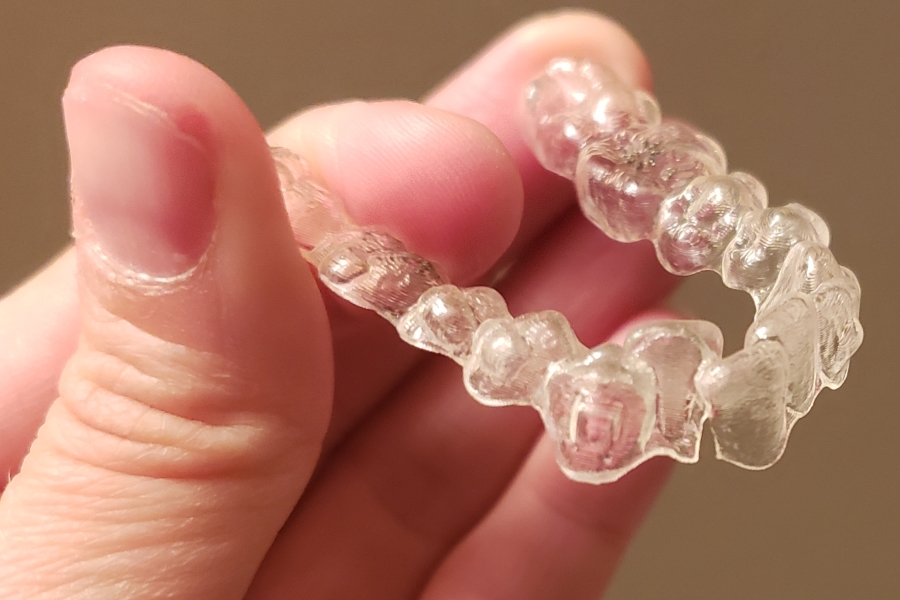“What if my Invisalign cracks?” It’s a common question patients have. In fact, after we wrote about the phenomenon last year, seven out of 10 of the top search queries bringing readers to our site were around the topic of Invisalign trays cracking or breaking.
As it turns out, Invisalign cracking or breaking is not a rare phenomenon. And people understandably want to know: How likely is it to happen? Why does it happen? And what can you do if your tray cracks or breaks?
To answer some of these questions, we posted in a popular forum on Reddit catering to the community of patients with Invisalign (r/Invisalign/). We asked what their experiences were with Invisalign, particularly with regard to cracking and breakage.
Here’s what we found:
Summary Stats for Invisalign Cracking
- A little under half of the respondents (45%) reported Invisalign trays cracking or breaking at some point during their treatment.
- Of those that had a tray crack or break, most (60%) reported it happening with the first or second tray.
- Most respondents reported the break happening near a canine tooth, or near a tooth that protruded/overlapped to a great degree.
How Likely Is It that an Invisalign Aligner Tray Will Crack?
A little under half of the respondents in our informal survey reported that they had cracked a tray at some point during their treatment. This is likely to be an overestimate, however. Because participation was voluntary, chances are much greater that a person would bother to participate if they did have a story about a cracked Invisalign tray, versus a treatment that went smoothly.
Still, even if we assume that someone is 10 times more likely to report a cracked tray, that would still leave roughly 8% of patients having a cracked tray at some point or another during treatment.
So, although these are not official numbers, there’s enough to say: It is not at all uncommon to have a tray crack on you. The majority of people, however, will go through treatment just fine without any cracks or breaks.
Why Do Invisalign Trays Crack?

There is no one single cause of trays cracking. But, looking at the stories of patients who’ve had a tray crack, we did start to notice some similarities.
Removing on just one side
Some of the most common stories had to do with trying to remove trays from one side only:
“I’ve cracked 3 of my trays out of 15… It happened because I would take the bottom tray out from one side only. I switched my method now, though. Now I pop off both sides to take it out, and it’s all good.”
“Mine did [break on my] 1st tray. I was frustrated at not being able to get them out easily and tried to rip it out from one side, did not realize they were a little fragile.”
Breaking at the most crooked teeth
Often, the break or crack would occur where a single tooth was most out of alignment (for example, protruding or overlapping severely):
“My bottom right canine…didn’t seem to fit the tray very well, as the tray protruded away from my gum/tooth quite a bit. So I did push on that part of the tray a little bit to reshape it to fit properly, which could have contributed to it cracking. I noticed the crack when I took them out to eat one afternoon.”
“One of my teeth is severely rotated and it always cracks at that tooth.”
“Cracked tray 2, 6th day, bottom. I have severe overcrowding, about 10 attachments, and it happened where my teeth are really overlapping.”
Timing (and experience) might matter too
Not every respondent mentioned which tray (or trays) cracked. But of those that did, virtually all of them had their break happen in the first three trays.
This suggests that part of the reason for cracking has to do with experience removing the trays. As patients learn the proper way to remove their trays carefully, they will be less likely to inadvertently stress or crack the trays.
This further suggests that dentists and orthodontists need to do a better job showing patients how to correctly remove their trays. (One user even mentioned that his office gave no advice beyond saying “You’ll eventually get it.”)
Cleaning tabs?
We should also mention that one user had problems with trays cracking when using cleaning tabs:
“My trays used to crack when I used those cleaning tabs to soak it in. I started using my water flosser to clean the trays after that and they always looked like new every time and had no issue with cracking.”
We don’t know why this would be the case, but it is something to watch out for if you are planning to get Invisalign. When you start treatment, have a plan in place for cleaning your Invisalign trays.
What Can You Do If Your Invisalign Tray Cracks?
(Also see our article, “My Invisalign is Cracking! What Should I Do?”)
The makers of Invisalign products advise you contact your dentist or orthodontist the moment you notice a crack. They will be able to give you the best advice about what to do about the cracked tray.
Your dentist’s advice about what to do if your Invisalign cracks will depend on how severe the damage is. In general, if it is just cracked and not split, you can continue wearing it until you are ready for your next tray.
For more severe cracks, what you do will depend on where you are in your progress toward the next tray. If you are in the early days of wearing a set of trays, your dentist or orthodontist might have you go back to the previous set of trays until a replacement can be made.
On the other hand, if you have worn the tray for more than eight days, you might be able to begin wearing the next tray in the series and skip replacing the cracked one. Again, your dentist or orthodontist can advise you best here.
Whatever you do, do not attempt to repair the tray yourself. Once a tray has cracked, it has lost the specific shape and strength it needs to properly align your teeth at that stage of the process. Attempting to repair the tray will just mean delaying your finish date. (Also, many super glues are toxic if you put them in your mouth.)
Advice for Preventing Cracks in Your Invisalign “Braces”
Knowing what to do in the event of a crack is one thing. Knowing how to prevent them is quite another.
Based on the stories we heard about Invisalign from real patients, we recommend the following actions to help prevent your Invisalign trays from cracking:
- Take the time to learn how to properly insert and remove your trays. Here are a couple of videos that can help:
- Be gentle when cleaning your Invisalign trays. If you use cleaning tabs, try to notice if these cause any problems. If they do, switch to brushing or using a water pick.
- Use the case provided when they are not in your mouth. Many breaks occur when they are dropped or set down somewhere and crushed.
- If you experience any pain or discomfort with your Invisalign, address it immediately. Uncomfortable trays will tempt you to play or fidget with your trays, which will put stress on them.



